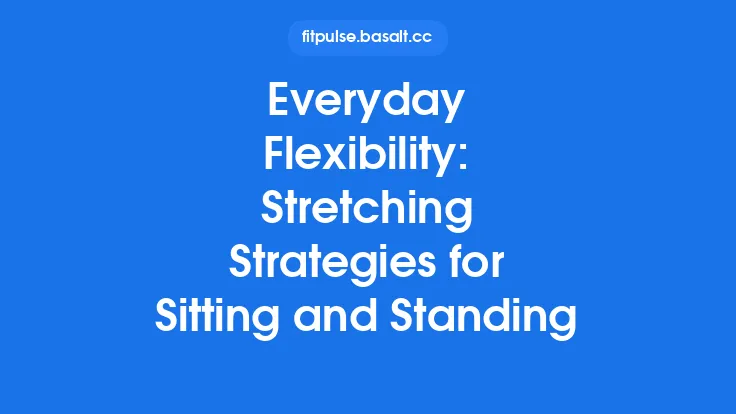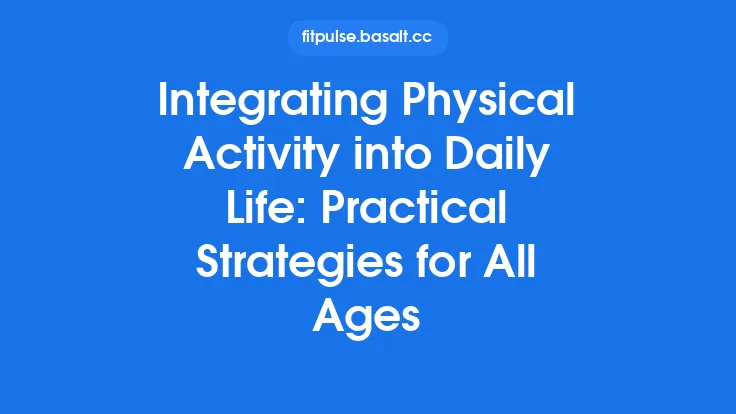In today’s increasingly sedentary work culture, the simple act of stepping away from the desk for a few minutes can be a game‑changer for both physical health and cognitive performance. While many organizations focus on ergonomic furniture or perfecting desk setups, the rhythm of movement throughout the day often receives far less attention. Incorporating intentional movement breaks—short, purposeful periods of activity interspersed between work tasks—offers a practical, evidence‑based strategy to counteract the physiological downsides of prolonged sitting and to foster a more resilient, productive workforce.
The Science Behind Movement Breaks
1. Metabolic Shifts
When a person remains seated for extended periods, muscle activity drops dramatically, leading to reduced glucose uptake and a decline in lipoprotein lipase activity—an enzyme critical for triglyceride clearance. Even brief bouts of ambulation (e.g., a 2‑minute walk) reactivate skeletal muscle contractions, prompting a rapid surge in insulin‑sensitive glucose transporters (GLUT4) to the cell surface. This metabolic “reset” helps maintain blood sugar stability and mitigates the risk of insulin resistance over time.
2. Vascular Dynamics
Static postures promote venous pooling in the lower extremities, increasing hydrostatic pressure and potentially contributing to peripheral edema. Light activity stimulates the calf muscle pump, enhancing venous return and reducing the likelihood of deep‑vein stasis. Studies using Doppler ultrasound have shown that a 5‑minute walk can restore femoral vein flow velocity to baseline levels observed after a period of standing.
3. Neurological Activation
The brain’s default mode network (DMN) becomes overactive during monotonous, low‑stimulus tasks, which can lead to mental fatigue. Movement breaks introduce novel sensory input and proprioceptive feedback, re‑engaging the executive control network (ECN). Functional MRI data reveal that brief locomotor activity increases prefrontal cortex oxygenation, correlating with improved attention and working memory in subsequent tasks.
4. Hormonal Modulation
Physical activity, even at low intensity, triggers the release of catecholamines (epinephrine, norepinephrine) and endorphins. These neurochemicals elevate mood, reduce perceived stress, and improve pain thresholds. A 3‑minute brisk walk has been shown to lower cortisol concentrations by up to 15% within 30 minutes post‑activity, supporting a more balanced stress response throughout the workday.
Physiological Benefits of Periodic Activity
| System | Primary Benefit | Mechanism |
|---|---|---|
| Musculoskeletal | Maintains joint range of motion | Synovial fluid circulation is enhanced by joint movement, reducing stiffness |
| Cardiovascular | Improves endothelial function | Shear stress from increased blood flow stimulates nitric oxide production |
| Metabolic | Stabilizes glucose and lipid profiles | Repeated muscle contractions promote GLUT4 translocation and lipoprotein lipase activity |
| Neurological | Boosts alertness and cognitive flexibility | Increased cerebral blood flow and catecholamine release |
| Immune | Enhances immune surveillance | Moderate activity mobilizes leukocytes, improving pathogen detection |
Collectively, these benefits create a virtuous cycle: better physiological function supports higher mental performance, which in turn encourages adherence to movement break routines.
Designing an Effective Break Schedule
1. The “Micro‑Cycle” Model
Instead of a single long lunch break, consider dividing the workday into micro‑cycles of 60–90 minutes of focused work followed by a 3–5 minute movement break. This aligns with the ultradian rhythm—a natural 90‑minute cycle of physiological arousal and decline—allowing workers to capitalize on peak alertness periods.
2. Frequency vs. Duration Trade‑off
Research indicates that a series of short, frequent breaks (e.g., 2 minutes every 30 minutes) can be as effective as fewer, longer breaks (e.g., 10 minutes every 2 hours) for metabolic outcomes. However, longer breaks may be more beneficial for cardiovascular strain reduction. Tailor the schedule to the specific health goals of the workforce.
3. Task‑Based Triggers
Link movement breaks to natural task boundaries—completion of an email batch, the end of a meeting, or the receipt of a new assignment. This reduces the cognitive load of remembering to take a break and integrates movement into existing workflow patterns.
4. Personalization Algorithms
Advanced scheduling tools can incorporate individual data (e.g., heart rate variability, step count) to dynamically adjust break timing. For instance, a worker whose HRV indicates rising stress may receive a prompt for a brief walk earlier than scheduled.
Types of Movement Breaks for Different Work Environments
| Environment | Recommended Break Activity | Rationale |
|---|---|---|
| Open‑Plan Office | 3‑minute corridor walk | Utilizes available space, promotes social interaction without disrupting colleagues |
| Private Cubicle | Desk‑to‑door stretch walk | Minimal disruption, encourages a change of visual scenery |
| Remote Home Office | Stair climb series (2‑3 flights) | Leverages home architecture, provides cardiovascular stimulus |
| Manufacturing Floor | Light tool‑free task rotation | Reduces repetitive strain while maintaining production flow |
| Field Work (e.g., surveying) | “Stationary mobility” (ankle circles, hip hinges) | Allows movement without abandoning equipment or site safety protocols |
The key is to select activities that are feasible within the physical constraints of the workspace while still delivering the physiological stimulus needed for health benefits.
Integrating Movement into Remote and Hybrid Workflows
Remote workers often experience fewer natural prompts to move, as the commute and office foot traffic are absent. To counteract this:
- Virtual “Walk‑and‑Talk” Meetings – Encourage participants to join a video call while walking in a safe indoor or outdoor environment. This maintains collaboration while adding physical activity.
- Scheduled “Active Hours” – Designate specific blocks (e.g., 10:00–10:15 am) where all team members are encouraged to step away from screens. Calendar invites can serve as reminders.
- Home‑Based Activity Zones – Advise employees to set up a small “movement corner” with a yoga mat or a step platform, making it easier to transition into a break.
- Gamified Challenges – Use platforms that track steps or active minutes and create friendly competitions across departments, fostering a culture of movement even when employees are dispersed.
Technology Tools to Prompt and Track Breaks
| Tool Category | Example | Core Functionality |
|---|---|---|
| Desktop Prompt Software | Workrave, Stretchly | Pop‑up reminders based on customizable intervals; optional activity suggestions |
| Wearable Integration | Fitbit, Apple Watch | Detect prolonged inactivity and deliver haptic alerts; log active minutes automatically |
| Mobile Apps | MoveMinder, Stand Up! | GPS‑aware prompts for outdoor walking; integrates with calendar events |
| Enterprise Platforms | Microsoft Viva Insights, Google Workspace “Wellbeing” | Aggregates data across users, provides analytics on break compliance, suggests organization‑wide policies |
| Ambient Sensors | Desk‑mounted pressure sensors | Detect sitting posture and trigger alerts when static pressure exceeds a threshold |
When selecting tools, prioritize those that allow for data privacy, customizable frequency, and integration with existing productivity suites to minimize friction.
Organizational Policies and Culture Change
1. Leadership Modeling
Executive endorsement is critical. When senior staff visibly take movement breaks—e.g., walking to a standing meeting—they set a normative precedent that legitimizes the practice.
2. Formal Break Policies
Incorporate movement break guidelines into the employee handbook, specifying recommended intervals and permissible activities. Align these policies with occupational health and safety regulations to ensure compliance.
3. Physical Infrastructure Support
Even without a full ergonomic overhaul, simple modifications—such as clear pathways for short walks, signage encouraging stair use, or designated “movement zones”—can facilitate break adherence.
4. Incentive Structures
Reward teams that achieve high break compliance rates with wellness credits, extra break time, or recognition in company communications. Positive reinforcement sustains long‑term behavior change.
5. Training and Education
Offer brief workshops on the science of movement breaks, emphasizing the link between activity, health, and performance. Provide practical guides on how to incorporate breaks without compromising workflow.
Assessing Impact and Adjusting Strategies
1. Baseline Metrics
Collect pre‑implementation data on key indicators: average daily steps, self‑reported fatigue levels, productivity scores (e.g., task completion time), and health markers (e.g., blood pressure, HRV).
2. Ongoing Monitoring
Utilize wearable or software analytics to track adherence rates and physiological responses. Quarterly surveys can capture subjective experiences such as perceived stress and job satisfaction.
3. Data‑Driven Refinement
Analyze trends to identify optimal break frequencies for different departments. For example, a knowledge‑intensive team may benefit from more frequent, shorter breaks, whereas a logistics crew may prefer longer, less frequent activity periods.
4. Reporting
Share aggregated results with the workforce to demonstrate tangible benefits—e.g., “Teams that took an average of 4 movement breaks per day reported a 12% reduction in self‑rated fatigue.”
Common Barriers and Solutions
| Barrier | Underlying Cause | Practical Solution |
|---|---|---|
| Perceived loss of productivity | Fear that time away equals less output | Educate on research showing post‑break performance spikes; pilot a “focus‑break‑focus” cycle to demonstrate net gains |
| Lack of suitable space | Small office footprint or home constraints | Promote “in‑place” mobility (e.g., marching in place, heel‑toe raises) that require minimal space |
| Forgetting to take breaks | Habitual screen focus | Deploy automatic prompts with escalating urgency; integrate break triggers into existing software (e.g., calendar alerts) |
| Cultural stigma | “Always‑on” mentality | Leadership to publicly endorse breaks; embed break language in meeting agendas (“Let’s reconvene after a quick walk”) |
| Physical limitations | Mobility impairments or chronic conditions | Offer alternative low‑impact activities (e.g., seated leg lifts, upper‑body mobility drills) and consult occupational health professionals for individualized plans |
Addressing these obstacles proactively ensures that movement break initiatives are inclusive and sustainable.
Practical Implementation Checklist
- Define Objectives – Clarify whether the focus is metabolic health, mental acuity, or overall wellbeing.
- Select Break Frequency – Choose a micro‑cycle (e.g., 60 min work / 5 min break) aligned with organizational rhythms.
- Choose Activities – Curate a menu of movement options suitable for each workspace type.
- Deploy Prompt System – Install software or configure wearable alerts; test for optimal timing.
- Communicate Policy – Distribute clear guidelines, emphasizing leadership support.
- Train Staff – Conduct brief sessions on the benefits and practical execution of breaks.
- Monitor Compliance – Track adherence via digital tools; collect self‑report data.
- Evaluate Outcomes – Compare pre‑ and post‑implementation metrics; adjust schedule as needed.
- Celebrate Successes – Recognize teams or individuals who exemplify consistent participation.
- Iterate Annually – Review emerging research and update the program to maintain relevance.
By following this roadmap, organizations can embed movement breaks into the fabric of daily work life, fostering a healthier, more resilient workforce without the need for extensive equipment upgrades or major structural changes.
Incorporating movement breaks is not a fleeting wellness fad; it is a scientifically grounded, scalable strategy that aligns physiological health with cognitive performance. When thoughtfully designed and culturally reinforced, regular periods of activity transform the modern workplace from a static environment into a dynamic ecosystem—one where bodies move, minds stay sharp, and productivity thrives.





